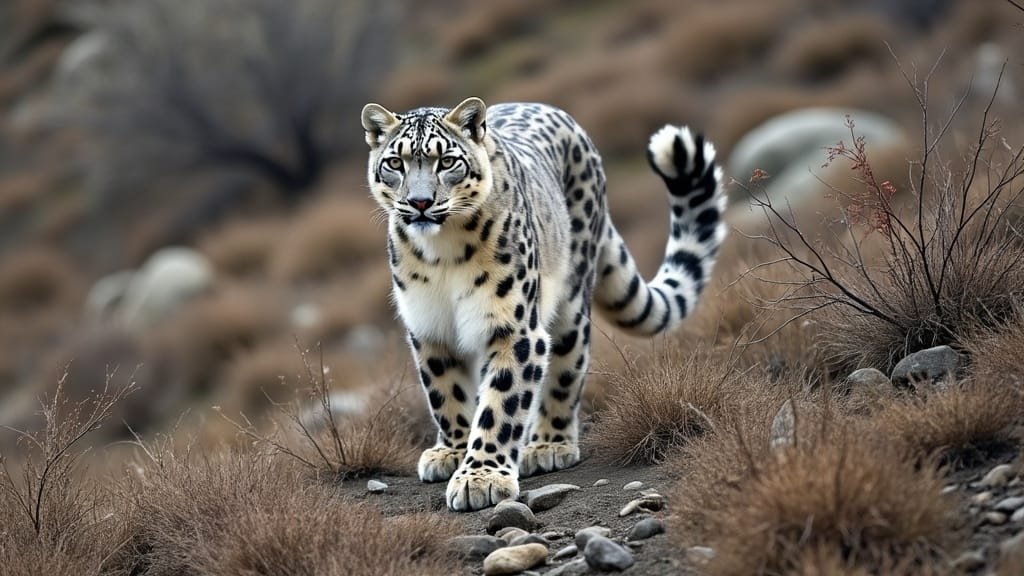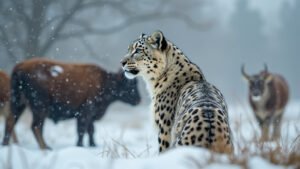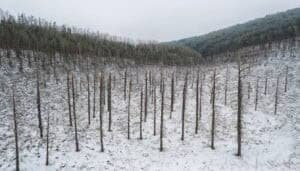Introduction
Prey depletion is one of the most significant challenges snow leopards face in their high-altitude habitats. As natural prey populations decline due to overgrazing, hunting, and habitat loss, snow leopards must adapt by altering their movement patterns, expanding their range, or preying on livestock
These adaptations often lead to increased conflict with humans and further threaten snow leopard populations. In this article, we will explore the causes of prey depletion, its effects on snow leopards, and the conservation efforts needed to address this pressing issue
Understanding Prey Depletion and Its Causes
Snow leopards rely on a delicate balance in their ecosystems, where prey availability directly impacts their survival. The depletion of prey species disrupts this balance, forcing these predators to adapt in ways that can jeopardize their long-term viability
Understanding the causes of prey depletion is essential for developing strategies to mitigate its impact on snow leopards and their habitats
Natural and Human-Induced Factors Behind Prey Depletion
Prey depletion can result from a combination of natural and anthropogenic factors. While natural fluctuations in prey populations occur due to disease, predation, and environmental changes, human activities are the primary drivers of significant prey loss
Overgrazing by domestic livestock is one of the leading causes of prey scarcity in snow leopard habitats. When grazing areas become depleted, wild herbivores like blue sheep and ibex must compete with livestock for food, often leading to population declines
Hunting and poaching also contribute to prey depletion. In many parts of Central and South Asia, prey species such as ibex, argali, and marmots are hunted for their meat, skins, and traditional medicinal uses. This overexploitation reduces the prey base available to snow leopards, forcing them to adapt their hunting strategies
Bagchi et al. (2006) emphasize that unsustainable hunting practices in snow leopard territories have significantly decreased prey density, further endangering these predators
Habitat loss and fragmentation exacerbate the issue. Infrastructure development, including roads, mining, and agriculture, encroaches on the natural habitats of prey species, reducing their populations and range
Additionally, climate change impacts vegetation patterns, further limiting food resources for herbivorous prey and disrupting their distribution across the landscape
Key Prey Species Affected by Declining Populations
The primary prey species for snow leopards include blue sheep (bharal), Siberian ibex, Himalayan tahr, argali sheep, marmots, and pikas
Each of these species plays a vital role in supporting snow leopard populations, yet all face varying degrees of decline due to human and environmental pressures
For instance, studies by Mishra et al. (2004) show that in areas with high livestock densities, blue sheep populations decline significantly, leading to increased competition for limited grazing areas. Similarly, Himalayan tahr populations are threatened by habitat encroachment and hunting, further reducing their numbers in critical snow leopard territories
Small prey species like marmots and pikas, while not the primary food source, are also important for supplementing the snow leopard diet during prey-scarce periods
The decline of these species, due to habitat changes and overharvesting, further limits the options available to snow leopards
Broader Ecological Implications
The loss of prey species affects not only snow leopards but also the broader ecosystem. As apex predators, snow leopards play a crucial role in regulating prey populations and maintaining the health of mountain ecosystems
When prey populations decline, the balance of these ecosystems is disrupted, leading to cascading effects that can impact vegetation, soil quality, and biodiversity
Addressing prey depletion requires a multifaceted approach, combining conservation efforts for prey species with strategies to minimize human impacts on snow leopard habitats
By understanding the causes and effects of prey depletion, we can work toward creating a sustainable future for snow leopards and their ecosystems
Impact of Prey Depletion on Snow Leopards
Prey depletion profoundly affects snow leopards, disrupting their natural behaviors, survival strategies, and population dynamics
The scarcity of prey forces these elusive predators to adapt in ways that increase their vulnerability, both directly and indirectly. Understanding the specific impacts of prey shortages is crucial for implementing effective conservation strategies
Changes in Movement and Hunting Strategies
When prey becomes scarce, snow leopards must expand their range and increase their movement in search of food. Typically, these big cats are solitary and territorial, with males covering areas up to 200 square miles and females occupying smaller, overlapping territories
However, prey depletion can force snow leopards to travel beyond their established home ranges, leading to greater energy expenditure and exposure to new risks
Expanded movement also increases the likelihood of encounters with humans and other predators. For example, snow leopards might venture into lower-altitude areas, where livestock grazing is prevalent, or into regions dominated by other carnivores, such as wolves
These interactions can result in direct competition for resources, further exacerbating the effects of prey scarcity
In areas where prey density is critically low, snow leopards may resort to opportunistic hunting strategies. This includes targeting smaller or less ideal prey, such as rodents or birds, which may not provide sufficient caloric intake
Over time, these shifts in diet can impact the health and reproductive success of snow leopard populations
Effects on Survival and Reproduction
Prey depletion poses a direct threat to the survival of snow leopards. Without a stable food supply, individuals struggle to meet their energy needs, leading to malnutrition, weakened immunity, and increased mortality rates
Juvenile snow leopards are particularly vulnerable, as they rely on their mothers to provide food during the early stages of life. If a female cannot secure enough prey, her cubs may not survive to adulthood
Reproductive success is also closely tied to prey availability. Female snow leopards require sufficient energy reserves to reproduce and rear cubs successfully
In prey-depleted areas, females may delay reproduction or produce smaller litters due to the lack of resources. This reduced reproductive output can result in declining population numbers over time
Bagchi et al. (2006) found that in regions with low prey density, snow leopard populations exhibit slower growth rates and higher mortality. These findings highlight the importance of maintaining robust prey populations to support the long-term survival of snow leopards
Long-Term Implications for Population Dynamics
Prey depletion can have cascading effects on snow leopard populations. As individuals struggle to survive and reproduce, population densities decrease, leading to increased isolation of groups. This isolation reduces genetic diversity, making populations more vulnerable to disease, environmental changes, and other threats
Additionally, prey depletion disrupts the predator-prey balance within ecosystems. With fewer prey animals, snow leopards may be forced into greater competition with other carnivores, such as wolves or feral dogs, which can lead to increased mortality
Over time, these pressures can destabilize entire ecosystems, resulting in a loss of biodiversity and diminished ecosystem services
Effective conservation strategies must address the root causes of prey depletion to mitigate these impacts. Protecting prey species, restoring habitat connectivity, and reducing human interference are essential steps in ensuring that snow leopards can thrive in their natural environments
Human-Wildlife Conflict Driven by Prey Shortages
Prey depletion often pushes snow leopards into closer proximity with human settlements, where livestock becomes a convenient alternative food source
While this adaptation helps snow leopards survive, it significantly heightens human-wildlife conflict. These interactions can have dire consequences for both snow leopards and local communities, making the resolution of such conflicts a critical focus of conservation efforts
Increased Livestock Predation
When natural prey populations decline, snow leopards often turn to livestock such as sheep, goats, yaks, and cattle. This behavior is most common in areas where livestock grazing overlaps with snow leopard habitats
According to Chetri et al. (2017), livestock can constitute up to 70% of the snow leopard’s diet in regions with severely depleted prey populations
For herders, these losses represent a significant financial burden, particularly in remote mountainous regions where communities rely heavily on livestock for their livelihoods
A single predation event can result in substantial economic hardship, leading to frustration and resentment toward snow leopards
The situation is further complicated by the difficulty of protecting livestock in such challenging terrain. Traditional herding practices often leave animals vulnerable to predation, especially at night or during seasonal migrations to higher pastures
Snow leopards, being stealthy hunters, exploit these opportunities, further intensifying the conflict
Retaliatory Killings and Conservation Challenges
One of the most concerning consequences of livestock predation is the retaliatory killing of snow leopards by herders
In many cases, herders use traps, poison, or firearms to eliminate predators they perceive as threats to their livelihoods. These killings not only reduce snow leopard populations but also disrupt their natural behavior and social structure
Retaliatory actions can also create a negative cycle: as snow leopard numbers decline, the remaining individuals may face even greater difficulty finding natural prey, leading to an increased reliance on livestock and further conflict. This dynamic underscores the urgency of addressing the root causes of prey depletion and promoting coexistence between snow leopards and local communities
Chetri et al. (2017) highlight that retaliatory killings are a significant barrier to conservation efforts. Despite legal protections for snow leopards in many range countries, enforcement is often weak, and local communities may prioritize their immediate needs over long-term conservation goals
Strategies for Mitigating Human-Wildlife Conflict
Several conservation initiatives aim to reduce human-wildlife conflict by addressing the underlying issues of prey depletion and livestock predation:
Livestock Insurance Programs: These schemes compensate herders for losses due to snow leopard predation, reducing the financial impact of such events. By alleviating economic pressure, these programs discourage retaliatory killings and foster a sense of coexistence
Predator-Proof Enclosures: Simple interventions, such as building reinforced corrals or using guard animals, can significantly reduce livestock losses. These measures help protect livestock while allowing snow leopards to focus on natural prey
Community-Based Conservation: Involving local communities in conservation efforts is critical for fostering positive attitudes toward snow leopards. Programs like the Snow Leopard Trust work with herders to promote sustainable practices, such as rotational grazing and habitat restoration, which benefit both livestock and wildlife
Education and Awareness Campaigns: Educating communities about the ecological importance of snow leopards and the benefits of conservation can help shift perceptions. Highlighting the role of snow leopards in maintaining healthy ecosystems may encourage greater tolerance and support for conservation measures
Balancing Human and Snow Leopard Needs
Effective conflict resolution requires a balanced approach that considers the needs of both snow leopards and local communities
Conservation efforts must address the root causes of prey depletion by restoring natural prey populations and ensuring that snow leopards have access to adequate food sources. Simultaneously, strategies to mitigate livestock predation and reduce economic losses are essential for gaining community support
By fostering coexistence and reducing the drivers of conflict, conservation initiatives can create a sustainable future where snow leopards and humans share the same landscape in harmony
Conservation Solutions for Prey Depletion
Addressing prey depletion is vital for ensuring the survival of snow leopards. Effective conservation strategies require a combination of protecting prey populations, restoring habitats, and reducing human pressures on ecosystems
By focusing on both immediate and long-term solutions, these efforts aim to restore the balance between snow leopards, their prey, and the environment
Protecting and Restoring Prey Populations
Conserving prey species is a cornerstone of snow leopard conservation. This involves addressing the various factors contributing to prey depletion, such as overhunting, habitat loss, and competition with livestock:
Anti-Poaching Initiatives: Strict enforcement of anti-poaching laws is critical for protecting prey species like blue sheep, ibex, and Himalayan tahr. Conservation organizations often collaborate with local governments to monitor hunting activities and prevent illegal harvesting of these animals
Sustainable Hunting Practices: In regions where hunting is culturally or economically significant, promoting sustainable hunting practices can help maintain prey populations. Quotas and seasonal restrictions ensure that prey species are not overexploited, preserving them for both ecological and human needs
Habitat Restoration Projects: Restoring degraded habitats is essential for supporting prey populations. Efforts include reforestation, rewilding grazing areas, and improving water resources to ensure that prey species have access to food and shelter
Reducing Competition with Livestock: Managing livestock grazing is another key strategy. Initiatives like rotational grazing and setting aside wildlife-exclusive zones can help reduce competition between domestic animals and wild herbivores, allowing prey populations to recover
Reducing Human Impacts on Snow Leopard Habitats
Minimizing human interference in snow leopard habitats is critical for mitigating the effects of prey depletion. Conservationists and policymakers are working to limit the impact of infrastructure development, livestock grazing, and resource extraction in key snow leopard territories:
Wildlife Corridors: Establishing protected corridors that connect fragmented habitats allows snow leopards to migrate freely in search of prey. These corridors help maintain genetic diversity and reduce the risk of isolation caused by habitat fragmentation
Community-Based Conservation: Engaging local communities in habitat preservation fosters a sense of ownership and responsibility for conservation outcomes. Programs like the Global Snow Leopard and Ecosystem Protection Program (GSLEP) work with communities to promote sustainable land use practices that benefit both people and wildlife
Protected Areas and Reserves: Expanding protected areas is a direct way to safeguard critical habitats for snow leopards and their prey. In addition to creating new reserves, enhancing management and enforcement in existing protected areas ensures long-term conservation success
Leveraging Technology for Conservation
Advances in technology are providing new tools for monitoring prey populations and improving conservation efforts:
Camera Traps and GPS Tracking: These tools allow researchers to monitor snow leopard movements and prey abundance in real-time. Data collected through these technologies helps identify areas where conservation interventions are most needed
Drone Surveys: Drones are increasingly being used to map and assess habitat conditions in remote mountainous regions. These surveys provide valuable insights into prey distribution and habitat quality
Community Reporting Apps: Mobile applications enable local communities to report sightings of snow leopards and prey species, contributing to citizen science initiatives and improving data collection
International Collaboration for Prey Conservation
Prey depletion is a transboundary issue, as snow leopards often roam across national borders. Collaborative efforts involving multiple countries are essential for addressing this challenge
Programs like GSLEP bring together governments, NGOs, and researchers to tackle prey depletion at a regional scale
These collaborations focus on creating shared policies for habitat protection, prey management, and anti-poaching enforcement. By pooling resources and expertise, international partnerships enhance the effectiveness of conservation efforts
Future Directions
Conservationists recognize that addressing prey depletion is a long-term endeavor requiring sustained commitment. Ongoing efforts must adapt to emerging challenges, such as climate change and increasing human development in snow leopard habitats
By prioritizing prey conservation alongside broader ecosystem protection, these initiatives can ensure that snow leopards continue to thrive in their natural environments
Conclusion
Prey depletion presents a critical challenge to snow leopard survival, affecting their movement, behavior, and overall population dynamics
As natural prey populations decline due to overgrazing, habitat loss, and poaching, snow leopards are forced to adapt, often at great cost to their health and safety. These changes increase the likelihood of human-wildlife conflict, further exacerbating the threats they face
Conservation efforts aimed at addressing prey depletion have made significant strides through habitat restoration, prey protection, and community-based initiatives. Strategies such as anti-poaching laws, sustainable grazing practices, and predator-proof enclosures demonstrate the importance of balancing ecological needs with human livelihoods
Additionally, international collaborations and technological advancements are paving the way for more effective monitoring and intervention programs
Ultimately, protecting prey populations is not just about ensuring the survival of snow leopards but also about preserving the intricate balance of high-altitude ecosystems
By prioritizing prey conservation and fostering coexistence, we can secure a future where snow leopards continue to thrive as symbols of resilience and beauty in some of the world’s most challenging environments











